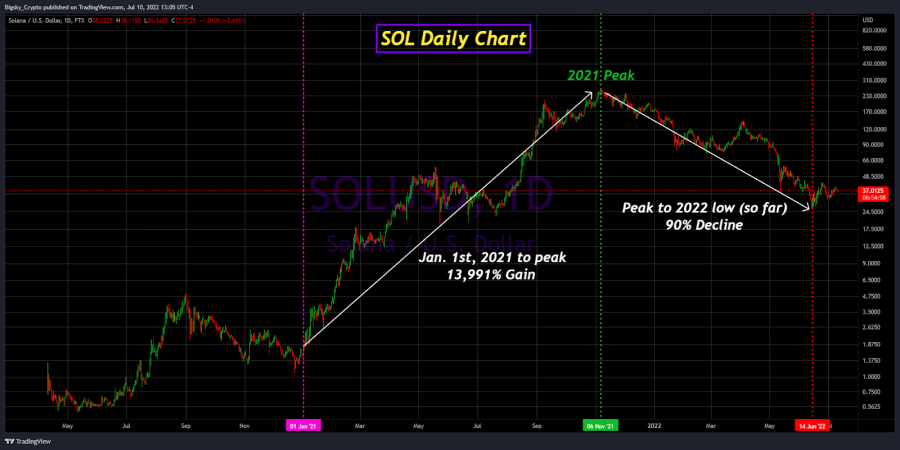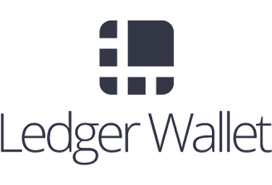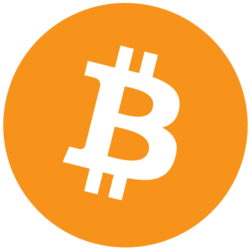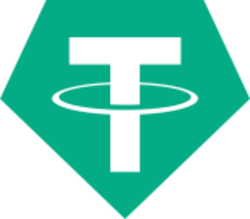
The post Is Solana Safe? by Donald Hancock appeared first on Benzinga. Visit Benzinga to get more great content like this.
Decided Solana (SOL) is safe for your risk tolerance? You can get (SOL) on eToro today.
Solana’s origins date back to 2017 when founder Anatoly Yakovenko published the whitepaper draft. The whitepaper was about a new time-keeping technique for distributed systems called proof-of-history (POH).
Ultimately, Yakovenko teamed up with a former Qualcomm Inc. (NASDAQ: QCOM) colleague, Greg Fitzgerald, to build the blockchain network. Yakovenko and Fitzgerald then teamed up with Stephen Akridge, also from Qualcomm, along with three others, to co-found a company that eventually would become Solana Labs.
The Solana mainnet was launched in March 2020 and is now billed as the fastest blockchain in the world, with 400 millisecond block times. Early 2018 development on a 50-node public testnet consistently supported 250,000 transactions per second (tps) bursts. Later in December 2018, the team published a permissioned testnet running 150 nodes on a gigabit network. It demonstrated an average of 200,000 tps during soak tests with bursts up to 500,000.
Today Solana advertises average transaction speeds of well over 2,000 TPS, over 82 billion total transactions and an average cost per transaction of $0.00025. Many blockchains are trying to achieve these transaction speeds and low cost, but few do. But, do these achievements prove that Solana is the perfect solution without issues? Keep reading to find out.
Table of contents
[Show]
How is Solana Secured?
Solana has a unique combination of PoH and proof-of-stake (PoS) consensus mechanisms. PoH is the main component of the Solana protocol and records successful operations and the time between them. This process ensures the trustless nature of the blockchain.
PoS consensus monitors the PoH processes and validates the blocks it produces. This combination makes the Solana blockchain one of the most unique in the blockchain industry. Solana, like Ethereum, is a Layer 1 blockchain with over 1,800 validator nodes.
Risks of Investing in Solana (SOL)
All investments carry risk, and investing in SOL is no different. The first risk involves price volatility. Looking back at 2021, the price started at $1.845 (FTX) and peaked on November 6 at $259.99, for an increase of about 13,991%. That increase marked an incredible gain in less than a year, but so far, 2022 is much different.

The price of SOL started 2022 at $179.09, but it has been all downhill since, hitting a low on June 14 at $25.78, for a decrease of about 82%. So you can see that buying at the right time will dramatically impact your investment. This is where a dollar cost averaging strategy over a long period could eliminate the need to time the market.
Another risk has to do with the monolithic construction of Solana, which can lead to centralization and security issues. A large concentration of on-chain wealth held by a small number of wallets can lead to problems with governance, limit the number of validators and reduce network security.
Other blockchains have opted to use a modular design for their blockchains to address scalability issues. These network include Polkadot, Cosmos, Avalanche, Polygon, and others. Validator costs can also be a negative consequence of a monolithically constructed blockchain. While there is no minimum amount of SOL needed to become a validator, voting on each block can cost up to 1.1 SOL daily. This cost could spiral out of control quickly.
Another potential issue is that Solana’s performance is directly related to the validator’s hardware and computer performance. Higher throughput is only achieved by more expensive hardware. A consequence of these vulnerabilities has already appeared in the form of repeated distributed denial-of-service (DDoS) attacks.

Is Solana Safe?
When considering if Solana is safe, it must be understood that “safe” is a relative term. One could argue that Solana is among the “safer” projects in relation to other cryptocurrencies. However, that doesn’t mean there are no inherent risks if you invest.
Besides the risks mentioned above, you should also consider smart contract risks. Smart contracts are not perfect and can suffer from operational, implementation and design risks. This fact doesn’t imply that Solana’s smart contracts are necessarily any less safe than its competitors’ smart contracts, but it is still something to consider.
The Solana blockchain is being developed by Solana Labs, which has 20 employees, including the four founders. Many team members are from Qualcomm, Microsoft and Apple, which gives the team great legitimacy. Solana is not risk free, but it helps the vetting process when the team is very transparent.
Where to Invest in Solana (SOL)
Being a top-tier cryptocurrency, SOL can be purchased at many different exchanges. The centralized exchanges (CEXs) include Binance (Binance.US), Bitfinex, Coinbase Global Inc. (NASDAQ: COIN), Crypto.com, eToro, FTX (FTX.US), Gemini, Robinhood Markets Inc. (NASDAQ: HOOD), SoFi Technologies Inc. (NASDAQ: SOFI), Webull and Voyager. These exchanges have user-friendly trading platforms, but Coinbase is probably the best for new investors.
You can also acquire SOL on Raydium and Solanax by swapping with USDT, USDC, or one of six other cryptocurrencies. Raydium and Solanax are Solana-blockchain-based automated market makers (AMM) that use decentralized exchanges order books to facilitate trades. You can trade on Solanax by connecting one of twelve wallets, including Phantom, Solflare and Ledger.
Solana Hacks
Crypto hacks are nothing new; they are, unfortunately, a reality of the crypto space. For example, 2021 was an especially bad year for hacks, with $3.2 billion in crypto stolen. Increasingly as the chart below shows, the target of these attacks are in decentralized finance (DeFi).

A secondary pattern also seems to be emerging in that the total number of hacks is far lower than in 2021, but the amount stolen per hack has increased substantially. However, 2022 isn’t over, so that could change.
Solana has not been immune to this pattern. Hackers have targeted either the Wormhole app or other protocols built on Solana. The Wormhole is a popular bridge connecting Solana with Ethereum. In that hack alone, over $326 million was stolen. Crema Finance was the latest victim, with $8.8 million stolen. After negotiations, the hacker returned the stolen funds for a $1.68 million bounty offered by the company.
As the trend shows, crypto hacks are not going away anytime soon, and investors should take all precautions to safeguard their crypto assets. This practice includes not storing large quantities of crypto on exchanges. Investors must also realize and accept the risks of keeping crypto on DeFi platforms.
It also includes keeping the bulk of crypto in cold storage using hardware wallets. At a minimum, investors should use software (hot storage) wallets rather than keeping crypto on exchanges. Undoubtedly, the hardware wallet is the best choice for anyone wanting the utmost security.
Best Hardware Wallet for Solana (SOL)
The previous section illustrates the risks of loss that every crypto investor faces. Therefore it is the responsibility of each investor to protect their crypto assets. When choosing where to store your crypto securely, look no further than a hardware wallet.
Hardware wallets are secure not only from the hardware they contain but also because they are isolated from the internet. The only time they are connected to the internet is when you are managing your crypto.
Best Hardware Wallet: Ledger

buy now
securely through Ledger Hardware Wallet’s
website
Launched in 2014, Ledger has transformed into a fast-paced, growing company developing infrastructure and security solutions for cryptocurrencies as well as blockchain applications for companies and individuals. Born in Paris, the company has since expanded to more than 130 employees in France and San Francisco.
With 1,500,000 Ledger wallets already sold in 165 countries, the company aims at securing the new disruptive class of crypto assets. Ledger has developed a distinctive operating system called BOLOS, which it integrates to a secure chip for its line of wallets. So far, Ledger takes pride in being the only market player to provide this technology.
Best For
- ERC-20 tokens
- All experience levels
- Easy to set up and use
- Supports more than 1,500 different digital assets
- Tamper proof
- Portable
- Long-lasting battery
- Bluetooth connectivity features
- Can be quite pricey
The Ledger Nano X and Nano S hardware wallets are both among the best on the market. The Ledger Nano X is the cheaper of the two but holds fewer apps than the Nano S. Both Ledger wallets can be used with the Ledger Live app, which makes managing your crypto assets very easy.
Ledger takes security seriously; that is why it is the first and only hardware wallet on the market certified for its security by ANSSI, a French cybersecurity agency. Both Ledger wallets also use Secure Element chips, the same chips used in debit/credit cards and passports. Secure Element chips have been tested and certified by a third-party security lab.
The key to Ledger’s security is that your private keys are stored in the Secure Element chip and are not sent out for processing transactions. Also, the device’s firmware and all cryptographic operations are held within the Secure Element chip.
Bonus section: The macroeconomic environment remains challenging and could put additional downward pressure on the crypto market. How Bitcoin performs moving forward will have the most significant impact on the price of SOL.
Cryptocurrency Market Outlook
The entire crypto market remains in a bear market, which most likely has transitioned into a crypto winter. After hitting a low on June 18, just above $17,500, Bitcoin bounced and has been holding around the $20,000 level. Where and when Bitcoin will bottom is still unknown, but it’s possible that the price of Bitcoin could be close to a bottom now.
It’s also possible that the price of Bitcoin will ultimately see a similar percentage drop as the last two bear markets at around 85%. An 85% drop from the peak in November would put the price of Bitcoin down around $10,000. That would be an additional 50% drop from the current price.
Where the price of Bitcoin bottoms will have an enormous impact on the rest of the crypto market. Many altcoins have already experienced severe pullbacks from their peaks but could be in for much more pain if Bitcoin takes another leg lower.
Is Solana (SOL) a Safe Investment?
It’s up to each investor to determine the level of risk they are comfortable with. Whether or not SOL is a safe investment will depend on your risk tolerance. Judging SOL based on the overall cryptocurrency risk spectrum, SOL would fall near the safer end. However, you can rely on no guarantees of safety with crypto, which is why you shouldn’t invest more than you are willing to lose.
The post Is Solana Safe? by Donald Hancock appeared first on Benzinga. Visit Benzinga to get more great content like this.








